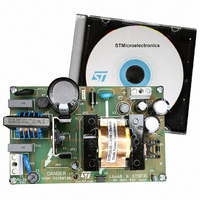EVALSTSR30-60W STMicroelectronics, EVALSTSR30-60W Datasheet - Page 16

EVALSTSR30-60W
Manufacturer Part Number
EVALSTSR30-60W
Description
BOARD EVAL USING L6668 & STSR30
Manufacturer
STMicroelectronics
Type
AC/DC Switching Convertersr
Specifications of EVALSTSR30-60W
Mfg Application Notes
EVALSTSR30-60W AppNote
Main Purpose
AC/DC, Primary and Secondary Side
Outputs And Type
1, Isolated
Power - Output
60W
Voltage - Output
12V
Current - Output
5A
Voltage - Input
88 ~ 264VAC
Regulator Topology
Flyback
Frequency - Switching
68kHz
Board Type
Fully Populated
Utilized Ic / Part
L6668, STSR30
Input Voltage
88 V to 264 V
Output Voltage
12 V
Dimensions
120 mm x 75 mm
Product
Power Management Modules
Silicon Manufacturer
ST Micro
Silicon Core Number
L6668 And STSR30
Kit Application Type
Power Management - Voltage Regulator
Application Sub Type
SMPS
Kit Contents
Board
Lead Free Status / RoHS Status
Lead free / RoHS Compliant
For Use With/related Products
L6668, STSR30
Other names
497-6389
EVALSTSR30-60W
EVALSTSR30-60W
Available stocks
Company
Part Number
Manufacturer
Quantity
Price
L6668
Figure 40. Load-dependent operating modes: timing diagram
The operating range of the voltage V(SKIPADJ) is practically limited upwards by the onset of audible
noise: typically, with a voltage above 2-2.1V some noise can be heard under some line/load conditions. If,
instead, V(SKIPADJ) is set below the low saturation value of the PWM control voltage (1.4V typ.) burst-
mode operation will never take place. Always bias the pin at some voltage, a floating pin will result in
anomalous behavior. The SKIPADJ pin doubles its function: if the voltage is pulled below 0.8V the IC is
disabled completely, except for the externally available reference voltage VREF, and its quiescent con-
sumption reduced. The soft-start capacitor is discharged so that, when the voltage on the SKIPADJ pin is
pulled above 0.8V, the chip is soft-started just like exiting from UVLO. This function is useful for some kind
of remote ON/OFF control. The comparator referenced to 0.8V does not have hysteresis; hence make
sure that the voltage on the pin does not linger on the threshold to prevent uncertain behavior.
4.4 PWM control Block
The device is specific for secondary feedback. Typically, there is a TL431 at the secondary side and an
optocoupler that transfers output voltage information to the PWM control at the primary side, crossing the
isolation barrier. The PWM control input (pin #10, COMP) is driven directly by the phototransistor's col-
lector (the emitter is grounded to GND) to modulate the duty cycle.
4.5 Current Comparator, PWM Latch and Hiccup-mode OCP
The current comparator senses the voltage across the current sense resistor (Rs) on pin 12 (ISEN) and,
by comparing it with the programming signal derived form the control voltage on pin 10 (COMP), deter-
mines the exact time when the external MOSFET is to be switched off. The PWM latch avoids spurious
switching of the MOSFET, which might result from the noise generated ("double-pulse suppression").
16/23
V(SKIPADJ)
COMP
OUT
f
3.0V
osc
Fix. Freq.
Mode
Frequency Foldback Mode
Burst-mode
Fix. Freq.
hyster.
50 mV
Mode
t
t
t













